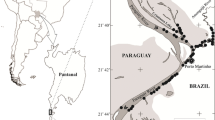Abstract
The age, growth, reproductive condition, and occurrence of natural hybrids of two Nematalosa species around Okinawa Island were examined using 128 specimens obtained from April 2003 to June 2004. Standard length (SL) reached approximately 150–210 mm within the first 2 years, and then remained stagnant. The maximum age for both sexes was ca. 5 years old. Maturity sizes and ages were estimated to be at least 173.2 mm SL and 2 years old for females and 192.6 mm SL and 3 years old for males. Spawnable individuals were mainly observed from January to March based on histological observations of gonads. Natural hybrids appeared at all sampling sites except for the Haneji Inlet and were dominant at Makiminato (in south-central Okinawa Island). Their incidence was also quite high (66.9%) in the Makiminato population, when compared with records for other marine fishes around Japan. In Okinawa Island, these shallow areas are rapidly decreasing in size because of recent reclamation and land exploitation. Hybrid production may be caused by not only the reproductive biology and sympatric distributions of the parent species but also recent environmental changes.





Similar content being viewed by others
References
Asahida T, Kobayashi T, Saitou K, Nakayama I (1996) Tissue preservation and total DNA extraction from fish stored at ambient temperature using buffers containing high concentration of urea. Fish Sci 62:727–730
Chen M, Hsiao J (1996) The reproductive biology of the gizzard shad, Nematalosa come (Richardson, 1846), in the Kaohsiung River and its harbor area, southern Taiwan. Zool Stud 35:261–271
Chubb CF, Potter IC (1984) The reproductive biology and estuarine movements of the gizzard shad, Nematalosa vlaminghi (Munro). J Fish Biol 25:527–543
Chubb CF, Potter IC (1986) Age and growth and condition of the Perth herring, Nematalosa vlaminghi (Munro) (Dorosomatinae), in the Swan Estuary, south-western Australia. Aust J Mar Freshw Res 37:105–112
Crow KD, Munehara H, Kanamoto Z, Balanov A, Antonenko D, Bernardi G (2007) Maintenance of species boundaries despite rampant hybridization between three species of reef fishes (Hexagarammidae): implications for the role of selection. Biol J Linn Soc 91:135–147
Ebisawa A (1990) Reproductive biology of Lethrinus nebulosus (Pisces: Lethrinidae) around the Okinawan waters. Nippon Suisan Gakkaishi 56:1941–1954
Imai H, Kashiwagi F, Cheng GH, Chen TI, Tachihara K, Yoshino T (2009) Genetic and morphological evidence of hybridization between Nematalosa japonica and N. come (Clupeiformes: Clupeidae) off Okinawa Island, Ryukyu Archipelago, Japan. Fish Sci 75:343–350
Masuda Y, Shinohara N, Takahashi Y, Tabeta O, Matsuura K (1991) Occurrence of natural hybrid between pufferfishes, Takifugu xanthopterus and T. vermicularis, in Ariake Bay, Kyusyu, Japan. Nippon Suisan Gakkaishi 57:1247–1255
Masuda Y, Ozawa T, Onoue O, Hamada T (2000) Age and growth of the flathead, Platycephalus indicus, from the coastal waters of west Kyusyu, Japan. Fish Res 46:113–121
Puckridge JT, Walker KF (1990) Reproductive biology and larval development of a gizzard shad, Nematalosa erebi (Günther) (Dorosomatinae: Teleostei), in the River Murray, South Australia. Aust J Mar Freshw Res 41:695–712
Pusey B, Kennard M, Arthington A (2004) Freshwater fishes of North-Eastern Australia. CSIRO, Melbourne
Uehara M, Imai H, Tachihara K (2009) Age and growth of two gizzard shads, Nematalosa come and N. japonica, in coastal waters around Okinawa Island, southwestern Japan. Fish Sci 75:295–301
Whitehead PJP (1985) FAO species catalogue. Vol. 7: clupeoid fishes of the world, part 1. An annotated and illustrated catalogue of the herrings, sardines, pilchards, sprats, shads, anchovies and wolf-herrings (FAO Fish Synop 125). FAO, Rome
Yamamoto K (1956) Studies on the formation of fish eggs I. Annual cycle in the development of ovarian eggs in the flounder, Liopsetta obscura. J Fac Sci Hokkaido Univ Ser VI Zool 12:362–373
Yokogawa K, Urayama K (2000) Natural hybrids between two species of puffer, Takifugu vermicularis and T. poecilonotus, obtained from the Seto Island Sea, Japan. Jpn J Ichthoyl 47:67–73
Yoshino T (2005) N. japonica. In: Nature Conservation Division of the Department of Culture and Environmental Affairs, Okinawa Prefectural Government (ed) Threatened wildlife in Okinawa. Okinawa Prefectural Government, Okinawa, p 184
You TL (1988) A preliminary study on reproductive biology of hairback herring Nematalosa japonica Regan, from Tungkang, Taiwan. Bull Taiwan Fish Res Inst 45:17–23
Acknowledgments
The authors are grateful to Emeritus Prof. S. Shokita and Associate Prof. T. Yoshino (University of the Ryukyus) for their kind support and useful advice. The authors thank Dr. A. Ebisawa (Okinawa Prefectural Fisheries and Ocean Research Center) for providing technical comments throughout this research and for critically reading this manuscript; Mr. K. Nakazato (Urasoe-Ginowan Fisheries Cooperative Association), Mr. Y. Kohatsu (Sashiki-Nakagusuku Fisheries Cooperative Association), Mr. Z. Touyama, and Mr. S. Touyama (Okinawa City Fisheries Cooperative Association), for collecting fresh specimens, Mr. I. Irei (Haneji Fisheries Cooperative Association), Mr. H. Ikeda, Mr. H. Komine, Mr. M. Ishimine, Mr. T. Maehara, and Mr. S. Nakasone (Okinawa City Fisheries Cooperative Association) for helpful support in obtaining and processing specimens, and the members of the Laboratory of Fisheries Biology & Coral Reef Studies (University of the Ryukyus) for their accommodating support during sampling. The authors are also grateful to Dr. N. Mochioka (University of the Kyusyu) and two anonymous reviewers for providing insightful comments to improve the manuscript. This research was supported in part by the Mikimoto Fund for Marine Ecology and a Grant-in-Aid for Scientific Research (C) (subject no. 22580206, representative: Katsunori Tachihara) from the Ministry of Education, Culture, Sports, Science and Technology, Japan.
Author information
Authors and Affiliations
Corresponding author
About this article
Cite this article
Uehara, M., Kashiwagi, F., Imai, H. et al. Biological traits of naturally induced hybrid individuals of two gizzard shads, Nematalosa come and N. japonica, in coastal waters around Okinawa Island, Ryukyu Archipelago, southwestern Japan. Ichthyol Res 58, 344–349 (2011). https://doi.org/10.1007/s10228-011-0237-z
Received:
Revised:
Accepted:
Published:
Issue Date:
DOI: https://doi.org/10.1007/s10228-011-0237-z




